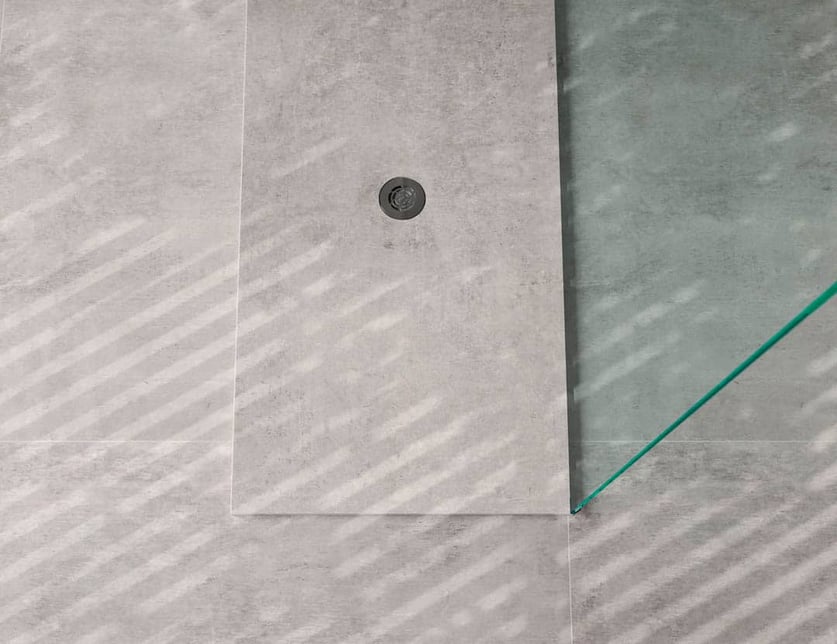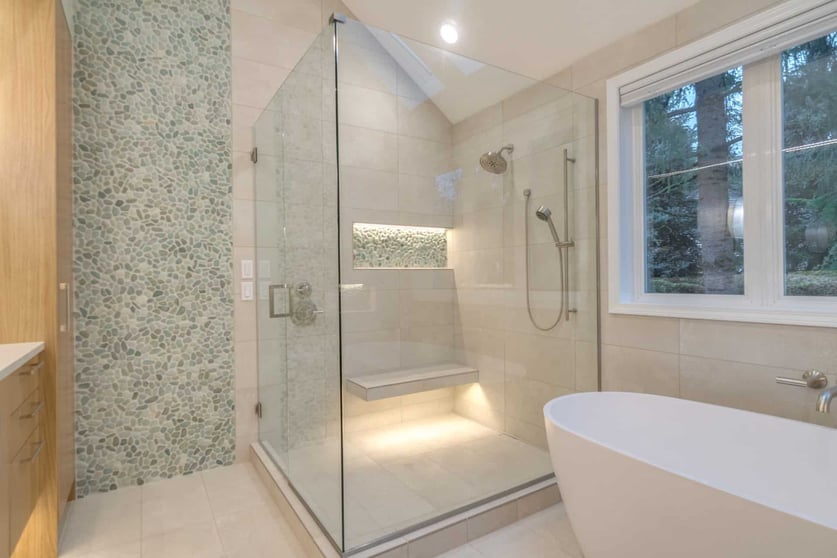If you’re in the process of building or remodeling a bathroom, you probably have a good idea of how you want your shower to look. You’ve probably settled on a size, location, and enclosure material, such as fiberglass, tile, or slab. But there’s one important design feature in a shower that often goes overlooked: the shower pan. But which type of shower pan is best for you?
As one of Portland’s leading design-build remodeling firms, Lamont Bros. has designed dozens of bathroom remodels. Part of every effective shower design is a functional shower pan. Although it may not be the most glamorous feature of your bathroom, it serves an important purpose. Because there are many different materials and styles to choose from, you should consider your options carefully before selecting a type shower pan for your bathroom.
In this article, you can learn about the different types of shower pans. We will discuss several of the most popular types, breaking down their strengths and weaknesses for you to consider. By the time you reach the end of this page, you should be able to identify which type of shower pan will work best for you in your home. You can expect to learn about:
- What a shower pan is and why it matters
- The different types of shower pans
- How to select the right shower pan for your bathroom
What is a shower pan and why do I need one?
Most simply, a shower pan is the floor of your shower. It is a waterproof barrier meant to keep moisture from getting into the floor or walls of your home. It must also channel shower water to the drain. It is typically 2-5 inches tall and resembles a shallow sink, which is essentially what it is.
You need a shower pan in your shower because it is one of the only ways to waterproof your shower enclosure. Most building materials are not waterproof and would otherwise be at risk of water damage. Drywall, hardwood floors, cabinets, and even framing can be harmed by uncontained water damage. A properly installed shower pan mitigates the risk of water damaging the non-waterproof parts of your bathroom.
What are the different types of shower pans?
Shower pans can be made of several different materials. They come in many sizes and visual styles, as well. In order to select the right shower pan for your bathroom, it’s important that you first know what makes each type unique.
Fiberglass/acrylic shower pan
The most basic, entry-level option available, a fiberglass or acrylic shower pan is functional and low cost. Fiberglass and acrylic are plastic-based materials. They are commonly used for shower and bathtub enclosures because they’re easy to manufacture, highly waterproof, and require little maintenance. However, because they are manufactured products, so it only comes in select sizes. If you’re looking for a more custom-sized or shaped shower, a fiberglass or acrylic pan may not work for you.
Though it lacks visual appeal and rarely comes in any color other than white, this is a great option if you want a shower pan that gets the job done at a low cost. And since the pan only covers the floor, you can use a different material for your shower walls to add variety and style.

Pros:
- Least expensive option
- Easy to install
- Low maintenance
Cons
- Lacks visual style or appeal
- Limited to specific sizes
- Few color options available
Dekton showertray
One of the newer players on the field of shower pans, the composite engineered surface material Dekton is an increasingly popular choice. It has long served as a countertop material in homes all over the world and is known for its durability and style. However, use as a shower floor is a relatively new development.
A Dekton showertray offers excellent durability without compromising on style. It arrives from the factory as a slab with an inward-sloped surface for drainage. While the slab itself comes in standard sizes, it is much easier to custom-fit Dekton material to a uniquely-shaped shower space.
Dekton tends to be in the mid-range for cost. In terms of visual appeal, it comes in a handful of styles that can evoke natural stone, concrete, or solid colors. As a synthetic material, the surface styles may sometimes look “fake” under close examination. However, if you’re using Dekton slim panels for your shower wall, a Dekton showertray is a great way to match the floor to your shower enclosure.

Pros
- Durable & strong material
- More stylish than fiberglass
- Can fit more unique spaces
Cons
- It’s a relatively new technology
- Surface design may appear synthetic
- Higher price
Cast iron shower pan

Reminiscent of the days of cast iron footed bathtubs, the cast iron shower pan invokes the age old saying, “If it ain’t broken, don’t fix it.” Iron is a great material for shower pans simply because it’s so strong and heavy. Of course, that comes with its challenges, too.
A cast iron shower pan features a solid-iron core coated with high-strength enamel. You’d be hard-pressed to find a more durable material on the market. It also offers a classic, timeless visual element that fit nearly any bathroom.
Like fiberglass, cast iron pans only come in select sizes and are therefore not well-suited for oddly-shaped showers. They’re also very expensive and heavy, which makes them difficult to install. However, once in place, chances are a cast iron shower pan will outlast anything else in the bathroom.
Pros
- Extremely strong, long-lasting material
- Classic & timeless visual appeal
- Easy to clean & maintain
Cons
- Very expensive
- Heavy & difficult to install
- Limited size & colors
Custom tile shower pan
By far the most customizable option in terms of shower pans, tile is a great choice for when you want a shower that is unique to you. A tile shower pan can feature large or small tiles in nearly every color known to man. It is by far the best option for showers that don’t meet the standard shape for prefabricated shower pans. However, the cost of tile installation also makes this the most expensive option.
Tile can also be difficult to maintain because of the grout, which requires regular cleaning. However, if unparalleled visual appeal and customizability are what you seek, a custom tile shower pan is the option for you. This design feature pairs well with both custom tile shower walls or with other upscale shower enclosures, such as a stone slab shower wall.

Pros
- Highly customizable
- Many style & color options
- Works with many upscale shower wall enclosures
Cons
- Most expensive due to labor
- Difficult & time consuming to install
- Grout requires maintenance
How to select the right type of shower pan for your bathroom
Each of the shower pan options mentioned above has its own advantages. Chances are, one will work best for your bathroom based on your personal needs and preferences. Here are a few things to consider while choosing a shower pan.
What look are you trying to achieve?
One of the most important things to consider when choosing your shower pan is how its visuals will interact with the bathroom as a whole. Usually, people choose their shower wall before they select the pan. As a result, the pan should match or complement the visual elements created by the shower walls.
If you’re doing a fiberglass shower wall, this decision is pretty easy. Just go with a fiberglass floor, too. It matches, and there’s no point in putting a higher-end floor with entry-level shower walls. Cast iron pans tend to fit more classic and traditional bathroom designs, while slab floors like the Dekton showertray are best for contemporary & modern bathrooms. Tile will fit with just about anything.
Do you have mobility restrictions to consider?
Mobility restrictions can play a huge part in what shower pan you select, as well. Curbless shower pans are usually great choices for people who might trip over the lip of a standard shower pan.
You might find curbless shower pans from a select few fiberglass or cast iron manufacturers. However the easiest approach is to use a Dekton showertray or tile floor. The slab shape of a Dekton tray lends itself nicely to being installed flush with the floor. A skilled tile setter can also install a curbless shower floor with relative ease.
How important is your shower pan to you?
One question you should ask yourself is whether the shower pan is something you’re willing to compromise on for the sake of cost. When it comes down to budget, sometimes you find yourself needing to make adjustments to lower the cost of your bathroom project.
For most people, the most important part of the shower is the walls, not the floor. For this reason, some might choose to use a less expensive shower pan so they can afford a more expensive wall enclosure. Consider whether this is something that is important to you so you can make budget adjustments later on if necessary.
Ready to talk to a designer about your bathroom remodel?
Now that you have a better idea of which type of shower pan is best for your bathroom, keep up the great research. Check out our Ultimate Bathroom Remodel Guide learn more about the process of remodeling your bathroom.
When you’re ready to start designing your bathroom remodel, click the button below to connect with a professional designer. We’ll do a free video consultation with you to answer any questions and help you get the ball rolling on your remodel.



